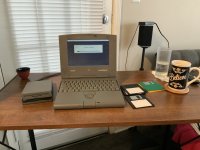Spidey01
Well-known member

Growing up in front of a Tandy 1000 with a single 5 1/2” drive as part of a PC family, it was well into the OS X era of the iMac and MacBook by the time I met anything Macintosh. By then I was already focused on BSD and Linux systems, so I largely missed the classic operating system. Probably strange by y’all’s perspective, but I was never a Mac user. Actually, my iPad Pro was the first Apple computer that I’ve ever owned. Most of my machines fall under PCs, usually running *nix unless video games are involved.
I’ve always liked the design of the ’90s era PowerBooks. Trying to learn more about the various models hardware is actually what lead me to finding 68kmla.org, although the wiki was a tad crashed at the time. Becoming increasingly tempted, and curious about the Mac operating system I never learned. I ended up finding a Duo 230 on eBay that was in good shape. Aside from a dead hard drive that sounded like the actuator for the drive head must have glued in place, but the seller was kind enough to describe its state. Gathered other bits and pieces while I wanted for it to arrive. I have an iBook G4 that runs OpenBSD/macpcc, so I was able to compile BasilliskII and putz around in the emulator a bit while I waited. The Duo turned out to be in far better shape than I had hoped, and the plastic less brittle than I feared.
Of course luck being what it is, about as fast as I could unplug it from the dock and go get my tools for disassembly: I heard the original power adapter go “Poof” in a cloud of smoke. Some open windows, and a four letter word later, it had to sit a few weeks to get past field stripping the system. Going into this project: I figured I would end up learning how to recap and need to do the charger. Didn’t expect it to die that fast however. Attempted to splice the larger tip from the Duo’s adapter onto an old G4 charger, based on how my iBook G4’s original owner had replaced a broken smaller tip with a three wired analog tip onto the charger’s fewer wires, but I was unsuccessful. Power supplies aren’t my area of expertise. The Duo’s adapter stunk so bad, I wasn’t inclined to pry it open and see if it could be repaired or used as recapping practice. Fortunately the G4 chargers for my iBook are still easy to find, but I went a tad nuts trying to figure out a power source for the old Duo.
In the end, I got a nice deal on a PowerBook G3 (Wallstreet series, maybe a PDQ) with a compatible charger. Thrift stores ftw. While I can’t say the G3 series interest me the way the older PowerBooks do, I have to admit having both an Apple floppy drive and a 10 Mbit/s Ethernet port in the same machine has proven very convenient for getting software loaded on the Duo. Using BasilliskII on an OpenBSD machine, I was able to experiment with the software while using the Wallstreet series to build System 7.5 install floppies. With luck, next week I should have a spare charger so that both machines can be powered at the same time. Seems like Apple really loved the 24v chargers with this style connector up until the last clamshell G3s or so, and you can guess which chargers are easier to find.
The Duo machine’s original 8 MB module with huge IC/s has been replaced by a 20 MB module that’s far younger looking. MiniDock and HDI-20 floppy drive acquired else where, so that I can use the floppy drive as my primary media exchange. But since the G3’s power adapter solved my first problem, I was able to focus on the second problem: internal storage. Refused to by a hard drive that probably dates back to when I was learning to read. In trying to learn up on the SCSI drives used in these machines and storage solutions, I ended up with a prebuilt BlueSCSI from Tech by Androda. As it turned out the little 3D printed PowerBook bracket was perfect for screwing into the mounting rails from the original SCSI drive. A spare MicroSD card, and a few hand gestures at a Disk Utils disk later, I had an optional machine at long last. In the future I plan to assemble a RaSCSI and set it up in one of these cases with my Raspberry Pi as an external drive to share between machines. Based on this plan, I decided to start with a 250 MB image for the BlueSCSI that better reflects the machines age. Meanwhile I plan for RaSCSI to be quite literally “Mass” storage.
A form factor like the Duo and it’s VHS style and portable docks would have sit really well with me when these machines were brand new, and it still kind of does. Give or take that I was still using MS-DOS 3 at the time these were made, lol. When I was younger, I found having a FreeBSD laptop invaluable for being able to get away and focus on my studies and a desktop for more intensive tasks. Something like the Duo would have been a superb form factor for my situation back then. In a great many ways it still reflects my tastes in form factor, if not processing power.
And thus goes the tale of my first 68K Macintosh.
